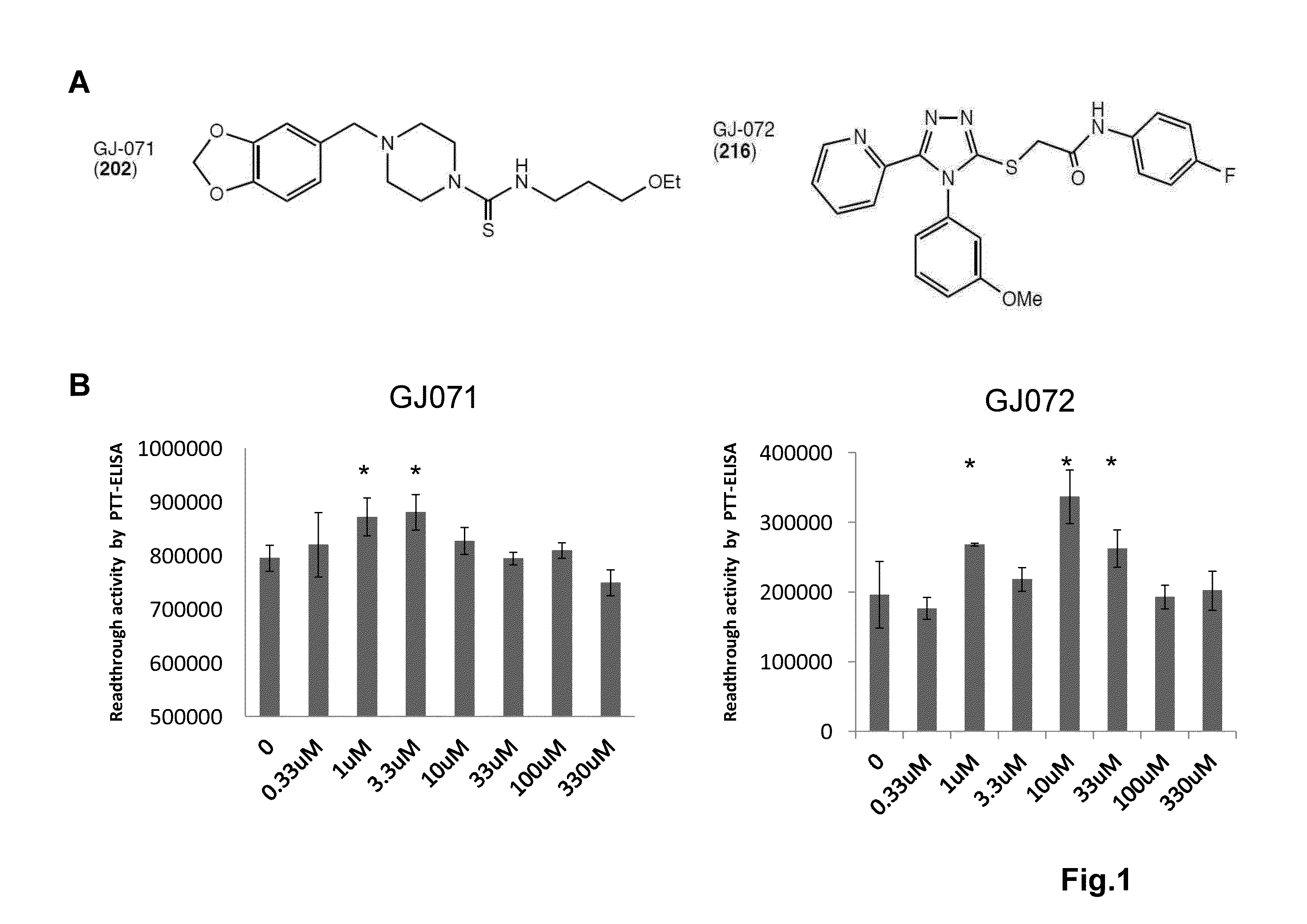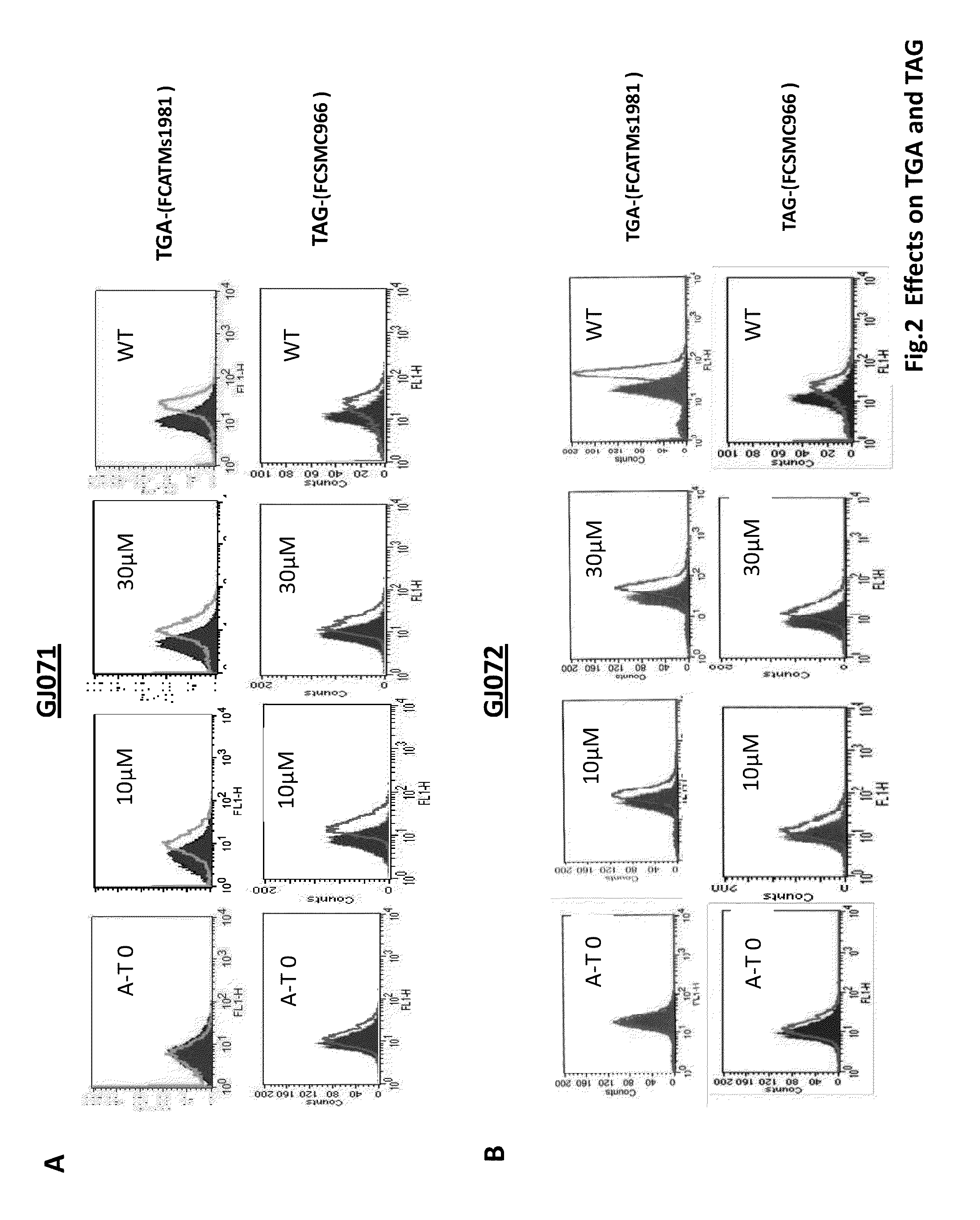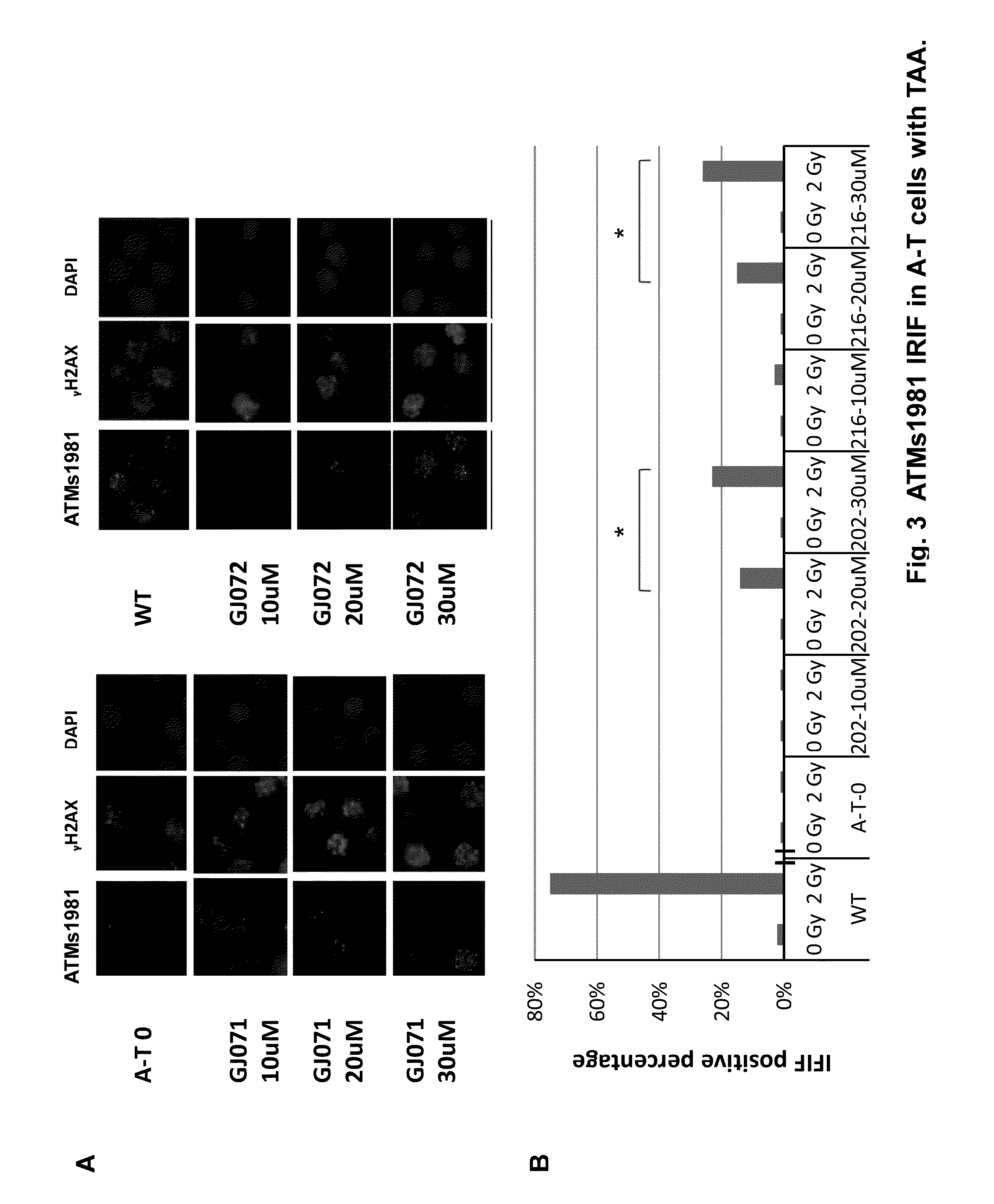Premature-termination-codons readthrough compounds
a technology of premature termination and readthrough, which is applied in the field of premature termination of codons (ptc) readthrough-inducing compounds, can solve the problems of ineffective treatment of a majority of genetics, no formation of target proteins or truncated proteins with impaired stability, and uncertainty of therapeutic effects, so as to suppress the premature stop codon and increase the transcription of genes. , the effect of enhancing production
- Summary
- Abstract
- Description
- Claims
- Application Information
AI Technical Summary
Benefits of technology
Problems solved by technology
Method used
Image
Examples
embodiments
[0124]The following paragraphs present a number of embodiments of the compounds disclosed herein. In each instance the embodiment includes both the recited compound(s) as well as a single stereoisomer or mixture of stereoisomers thereof, as well as a pharmaceutically acceptable salt thereof.
[0125]A series of 4,5-di-substituted 1,2,4-triazoles bearing a carbonyl- or carboxyl-methylthio substituent at C3, e.g., 1, showed very potent activity. A second set of compounds, 4-(3,4-methylenedioxyphenyl)methyl piperazines with various substituents on the N1 position 2 also showed read-through activity.
[0126]In some or any embodiments, the compound has a structure of formula (3) where A is C—R4 and B and C are both nitrogen and the compound has a structure of
[0127]In some or any embodiments of the compound, optionally in combination with any or all of the above various embodiments, R4 is 2-pyridyl for a compound of formula 1 or 3.
[0128]In some or any embodiments of the compound, optionally in...
synthetic examples 1a-1k
[0220]
Preparation of 2-(4-(3-methoxyphenyl)-5-(pyridin-2-yl)-4H-1,2,4-triazol-3-ylthio)acetic acid 1a
[0221]A mixture of triazolethione 5 (1.75 g, 6.2 mmol), 2-chloroacetic acid (584 mg, 5.1 mmol) and aqueous potassium hydroxide solution (2 M) (170 mL, 5.1 mmol) was refluxed for 3 h. The hot reaction mixture was filtered and the filtrate acidified with 2 M hydrochloric acid. The compound was precipitated out, filtered, washed with water. Recrystallization from an ethyl acetate / hexanes mixture gave 1a in 83% yield (1.76 g, light yellow solid). 1H NMR (500 MHz, (CD3)2SO): 8.37 (d, J=4.0 Hz, 1H), 7.99-7.91 (m, 2H), 7.44-7.38 (m, 2H), 7.09 (d, J=6.5 Hz, 1H), 6.98 (s, 1H), 6.90 (d, J=7.5 Hz, 1H), 4.10 (s, 2H), 3.73 (s, 3H). 13C NMR (125 MHz, (CD3)2SO): δ 169.6, 159.9, 153.9, 152.7, 149.4, 146.5, 137.5, 135.7, 130.5, 124.7, 123.9, 119.6, 115.2, 113.5, 55.8, 34.5 ppm.
[0222]Salt 1k: To a solution of 1a (1.0 mmol) in THF, was added 1.0 M aqueous NaOH (1.3 mmol). The reaction mixture was stirr...
synthetic examples 2b-2f
General Procedure for the Synthesis of Compounds 2b-2f
[0237]To a solution of 1-piperonylpiperazine 2a (157 mg, 0.71 mmol) in dichloromethane (5 mL), was added the appropriate isothiocyanate of formula R5NCS, e.g. allyl isothiocyanate (69 μL, 0.71 mmol) and triethylamine. The reaction mixture was stirred overnight at rt. The reaction mixture was poured into water, extracted with dichloromethane and the organic layers were dried with anhydrous sodium sulfate. The residue after removal of solvent was purified by silica gel column chromatography with ethyl acetate:hexane (2:1) and afforded compounds 2b-2f.
4-((Benzo[d][1,3]dioxol-6-yl)methyl)-N-methylpiperazine-1-carbothioamide 2e
[0238]1H NMR (500 MHz, CDCl3): δ 6.83 (s, 1H), 6.75-6.70 (m, 2H), 5.93 (s, 2H), 5.67 (bs, 1H), 3.79 (t, J=5.0 Hz, 1H), 3.42 (s, 2H), 3.14 (d, J=10.5 Hz, 3H), 2.45 (t, J=5.0 Hz, 4H). 13C NMR (125 MHz, CDCl3): δ182.9, 147.6, 146.7, 131.3, 122.1, 109.2, 107.8, 100.8, 62.3, 52.2, 47.3, 32.8 ppm.
BIOLOGICAL EXAMPLES
PUM
| Property | Measurement | Unit |
|---|---|---|
| weight | aaaaa | aaaaa |
| weight | aaaaa | aaaaa |
| weight | aaaaa | aaaaa |
Abstract
Description
Claims
Application Information
 Login to View More
Login to View More - R&D
- Intellectual Property
- Life Sciences
- Materials
- Tech Scout
- Unparalleled Data Quality
- Higher Quality Content
- 60% Fewer Hallucinations
Browse by: Latest US Patents, China's latest patents, Technical Efficacy Thesaurus, Application Domain, Technology Topic, Popular Technical Reports.
© 2025 PatSnap. All rights reserved.Legal|Privacy policy|Modern Slavery Act Transparency Statement|Sitemap|About US| Contact US: help@patsnap.com



